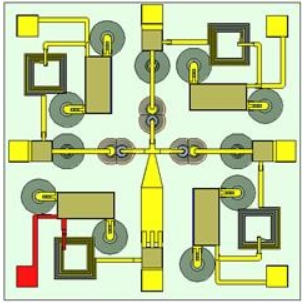MACOM UPDATES
- Articles
Designing with PIN Diodes: Discrete, HMIC or AlGaAs?
 At first glance, implementing a solid-state RF or microwave switch does not seem to be a daunting task: identify and evaluate an appropriate integrated circuit (IC) switch and if none exists, select PIN diodes to include in a discrete, custom design. Millimeterwave RF switches seem to be a bit more challenging, due to the high frequency of operation.
At first glance, implementing a solid-state RF or microwave switch does not seem to be a daunting task: identify and evaluate an appropriate integrated circuit (IC) switch and if none exists, select PIN diodes to include in a discrete, custom design. Millimeterwave RF switches seem to be a bit more challenging, due to the high frequency of operation.
As one investigates the products that are available for this task, their diversity can be overwhelming. Silicon discrete PIN diodes? MACOM’s silicon Heterolithic Microwave Integrated Circuit (HMIC) PIN diode integrated circuits? Gallium arsenide (GaAs) discrete PIN diodes? Aluminum gallium arsenide (AlGaAs) ICs? To compound matters, there are several viable circuit topologies, such as series-diodes-only, series-shunt diodes, shunt-diodes-only and more. How does a designer determine how to proceed?
Shunt PIN Diode SPDT
High Isolation Generic PIN SPDT


 The Discrete Design vs. Integrated Circuits
The Discrete Design vs. Integrated Circuits
It is generally easier to implement an integrated-circuit switch into a system than to design a discrete switch circuit. The IC switch designer is a specialist who chooses the optimal diode characteristics and switch topology to meet the switch’s required performance specifications. The IC switch user need only select the best IC and then design the appropriate control-signal bias decoupling networks. Some products, including MACOM’s IC switches, even include the bias decoupling networks.
Discrete diode switch designs can be optimized for specialized performance requirements for which an IC switch may not exist, such as insertion loss, isolation, power handling and switching time.

The HMIC Switch Process
MACOM’s HMIC technology joins glass and silicon into a single monolithic structure. The HMIC process uses automated batch process fabrication and testing technologies in order to produce diode structures, resistive and reactive lumped elements, all of which can be produced with small size and low loss for high performance microwave integrative circuits. Applied at the wafer level, this aims to substantially reduce the size, cost and performance limitations of the device, while also significantly improve the repeatability of conventional diode, active, passive, hybrid and chip-and-wire microwave circuits.
Due to characteristics of the HMIC wafer process, all of the PIN diodes in a HMIC switch design must have the same I layer thickness. HMIC switches can only include silicon PIN diodes, for which the upper frequency bound of operation is approximately 30 GHz.
The AlGaAs Switch Process
MACOM’s proprietary AlGaAs technology offers notable benefits, including ultra-broad bandwidth capability in the millimeter wave bands, low insertion loss, low bias current consumption, compact die sizes, BCB scratch protection and the availability of integrated bias networks.
In MACOM’s proprietary AlGaAs PIN diode technology, the anode layer of the diode is doped with a carefully-controlled concentration of aluminum. This can produce a larger band gap at the interface of the P and the I layers, which ultimately can produce a PIN diode with lower series resistance than an otherwise-identical GaAs PIN diode structure. The expected result is improved performance at millimeter wave frequencies up to and higher than 100 GHz.
Making the Best Decision
The approach a designer chooses to follow to implement a PIN diode switch function is influenced by many factors: the frequency and bandwidth of operation, power handling requirements, switching time requirements, maximum acceptable insertion loss, minimum required isolation and, not least, the circuit designer’s level of knowledge and experience with switch design. MACOM offers HMIC integrated circuit switches from single pole two throw to single pole four throw, AlGaAs integrated switches from single pole single throw to single pole eight throw and among the industry’s widest variety of discrete silicon, GaAs and AlGaAs PIN diodes.
RF Matters here at MACOM, and our industry leading applications engineering team is ready to help you succeed!